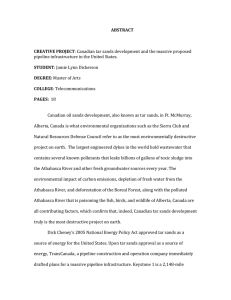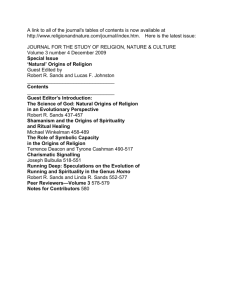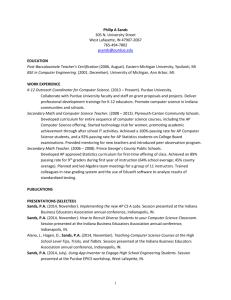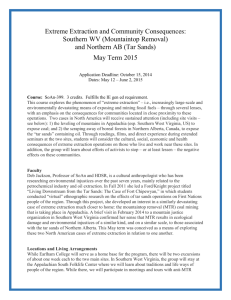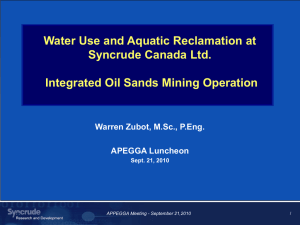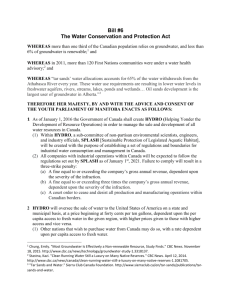ENV 202 – Policy Memo – Canadian Oil Sands Act
advertisement
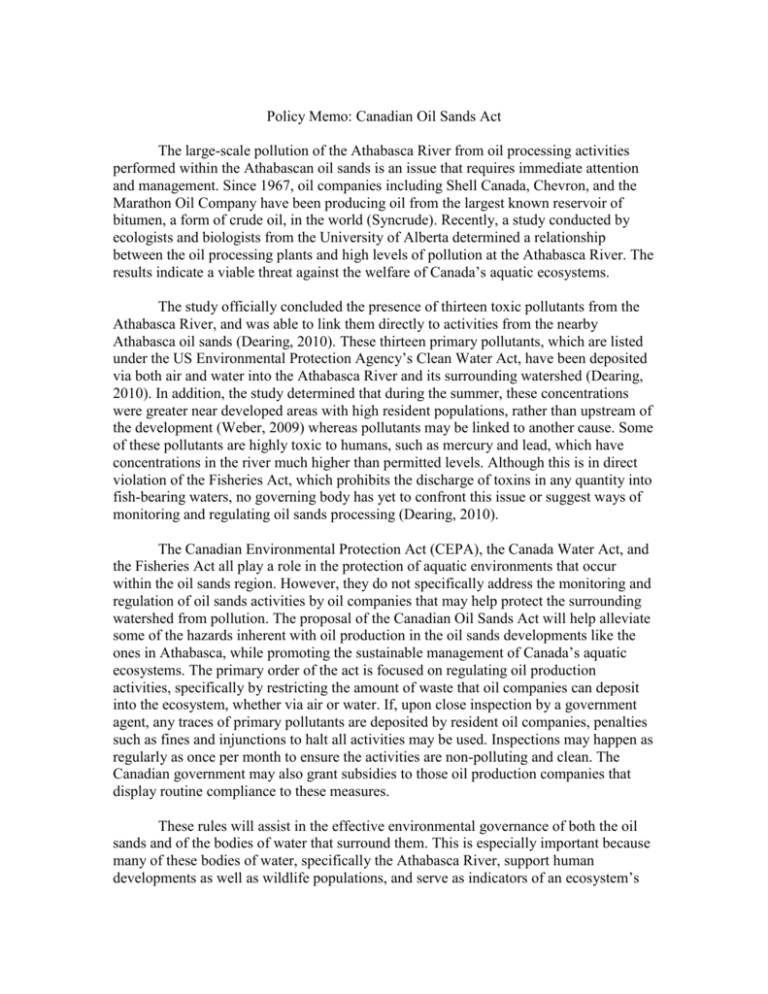
Policy Memo: Canadian Oil Sands Act The large-scale pollution of the Athabasca River from oil processing activities performed within the Athabascan oil sands is an issue that requires immediate attention and management. Since 1967, oil companies including Shell Canada, Chevron, and the Marathon Oil Company have been producing oil from the largest known reservoir of bitumen, a form of crude oil, in the world (Syncrude). Recently, a study conducted by ecologists and biologists from the University of Alberta determined a relationship between the oil processing plants and high levels of pollution at the Athabasca River. The results indicate a viable threat against the welfare of Canada’s aquatic ecosystems. The study officially concluded the presence of thirteen toxic pollutants from the Athabasca River, and was able to link them directly to activities from the nearby Athabasca oil sands (Dearing, 2010). These thirteen primary pollutants, which are listed under the US Environmental Protection Agency’s Clean Water Act, have been deposited via both air and water into the Athabasca River and its surrounding watershed (Dearing, 2010). In addition, the study determined that during the summer, these concentrations were greater near developed areas with high resident populations, rather than upstream of the development (Weber, 2009) whereas pollutants may be linked to another cause. Some of these pollutants are highly toxic to humans, such as mercury and lead, which have concentrations in the river much higher than permitted levels. Although this is in direct violation of the Fisheries Act, which prohibits the discharge of toxins in any quantity into fish-bearing waters, no governing body has yet to confront this issue or suggest ways of monitoring and regulating oil sands processing (Dearing, 2010). The Canadian Environmental Protection Act (CEPA), the Canada Water Act, and the Fisheries Act all play a role in the protection of aquatic environments that occur within the oil sands region. However, they do not specifically address the monitoring and regulation of oil sands activities by oil companies that may help protect the surrounding watershed from pollution. The proposal of the Canadian Oil Sands Act will help alleviate some of the hazards inherent with oil production in the oil sands developments like the ones in Athabasca, while promoting the sustainable management of Canada’s aquatic ecosystems. The primary order of the act is focused on regulating oil production activities, specifically by restricting the amount of waste that oil companies can deposit into the ecosystem, whether via air or water. If, upon close inspection by a government agent, any traces of primary pollutants are deposited by resident oil companies, penalties such as fines and injunctions to halt all activities may be used. Inspections may happen as regularly as once per month to ensure the activities are non-polluting and clean. The Canadian government may also grant subsidies to those oil production companies that display routine compliance to these measures. These rules will assist in the effective environmental governance of both the oil sands and of the bodies of water that surround them. This is especially important because many of these bodies of water, specifically the Athabasca River, support human developments as well as wildlife populations, and serve as indicators of an ecosystem’s health. Common pool resource management, which implies the sustainable use of our public goods and services through the implementation of regulations, is essential to providing for the Alberta economy by keeping the rivers free of pollutants and safe for recreational purposes. Overall, the Canadian Oil Sands Act will focus on regulating the emissions and pollutant depositions of oil companies situated near oil sands in an effort to more effectively manage Canada’s aquatic ecosystems. Word Count: 598 REFERENCES: Dearing, Stephanie. "Study Finds Alberta's Athabasca River Polluted by Oil Sands." Study Finds Alberta's Athabasca River Polluted by Oil Sands. N.p., 31 Aug. 2010. Web. 21 Sept. 2012. <http://digitaljournal.com/article/296829>. "Federal Legislation." - Regional Aquatics Monitoring Program (RAMP). N.p., n.d. Web. 21 Sept. 2012. <http://www.rampalberta.org/management/framework/federal.aspx>. "Fisheries Act (R.S.C., 1985, C. F-14)." Department of Justice. N.p., n.d. Web. 21 Sept. 2012. <http://laws-lois.justice.gc.ca/eng/acts/F-14/>. "Oil Sands History." Syncrude Canada Ltd. -. N.p., n.d. Web. 21 Sept. 2012. <http://www.syncrude.ca/users/folder.asp?FolderID=5657>. Weber, Bob. "Oilsands Pollution Exceeds Official Estimates: Study." Thestar.com. N.p., 7 Dec. 2009. Web. 21 Sept. 2012. <http://www.thestar.com/news/canada/article/735399--oilsands-pollutionexceeds-official-estimates-study>. "On my honor I have neither given nor received unauthorized information regarding this work, I have followed and will continue to observe all regulations regarding it, and I am unaware of any violation of the Honor Code by others."

